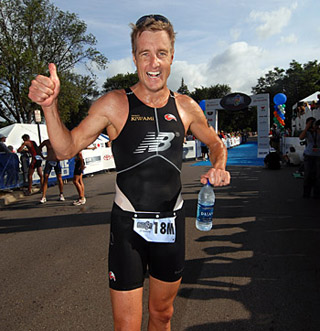Still on top of his game
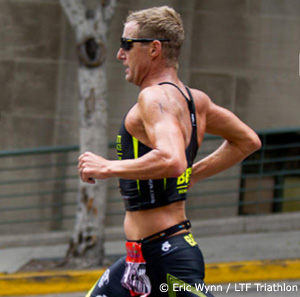
With his win at Hy-Vee, Greg Bennett added another bright shining trophy — and yet another huge payday — to a remarkably long and storied career. Bennett was winning ITU World Cups in 1998, was ranked world number one on the ITU World Cup circuit in 2002 and 2003, took 4th at the Athens Olympics and won a record $500,000 for his perfect 2007 season in the Lifetime Fitness / Toyota Cup series. But after a career threatening incident in which he was hit by a car in 2009 and a 4-month bout with an enervating virus in 2010, tri observers could be forgiven if they suspected Bennett at age 39 was on the inevitable downside of his career. Instead, Bennett shocked the world with a $151,500 victory that was a tribute to his competitive intelligence, a core of great talent, and a refusal to surrender. Bennett spoke to Slowtwitch last week as he prepared for The City of Los Angeles Triathlon.
Slowtwitch: What did this big win mean to you after more than two decades in the sport?
Greg Bennett: In the big picture, '06, '07 and '08 were very successful years for me. [In 2007, Bennett was perfect in the Life Time Fitness – Toyota Challenge series and won a total of $500,000 in prize money and bonuses] In '09, after winning NYC, I was hit by a car in August and lost several months. In 2010, I got a virus and was sick for 4 months in the middle of the year. So in those two years, I felt I never really got a great performances and I had to start wondering if I still had it.. With 40 just around the corner, I had to wonder. But I felt I did have it in my Australian summer (US winter) training in Noosa, Queensland, our Australian summer base.
ST: So let's get back to Hy-Vee and what it meant.
Greg: For me this win was important — it made me realize I still have it, sure.
ST: Have you turned away from your Olympic quest because you found some barriers to making the Olympic team?
Greg: Yeah I still would desperately love to make the US Olympic team. But there are quite a few things you have to do and I get a little frustrated with ITU and qualifying process. With their qualifying points system, you need to be studying consistently to figure out what you need to do. I was never that keen to do a lot of small little events. I enjoy big time races. Without feeling arrogant, I feel like I am beyond doing small, faraway Continental Cups to get points. Unfortunately the process requires it. For me to get a start in San Diego [the new US World Championship Series race which will also serve as the key remaining US Olympic qualifier] — I think they allow up to 8 American men — at this moment I don't think I am in the top 8. I do not like to do all those points races. I like to focus on big events. And that is my decision. Obviously I know that if I want to go to London I am meant to do them. I remain very keen to do the Olympics and I will try to make them in May and if I qualify I will put on a great show there. ,
ST: At minimum how many events do you have to do?
Greg: Probably two before the Sydney World Championship Series event in April. But to be honest, I am exhausted after pushing myself up to Hy-Vee. It is tough to train and get myself up for races at the end of year. So I will have to find events to start 2012. I do not have long years in me now. If I start in March I can to push myself through October with one or two peaks. If I go beyond that it is a struggle with diminishing returns. When I’m done, I know I’m done. It's the price I have to pay to get the best out of myself for the big races, when it counts.
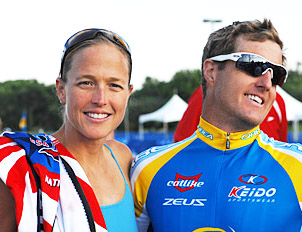
ST: Laura looks good for the Olympics, but the way the team qualification is structured she will have to fight it out with Sarah Haskins. Two star veterans fighting a Texas Death Cage wrestling match like Hunter and Andy in 2008.
Greg: Look I think the US would be mad if they did not put Laura on the Olympic team. She is the most consistent athlete in World Championship series races the last three years. There was only one time she was out of the top 8 in her last 10 starts. London was that exception, and the trouble was the race came during her women’s cycle, which is one of those things that really effect women in sport. It is a legitimate excuse and it affects a lot of women. The thing is she is so strong and so consistent I get irritated that she has to keep jumping through hoops. Laura needs to get a top 9 at San Diego [and beat Haskins]. If they leave her off the team, fine. She will go and do other racing. But in my mind it will be USA’s loss.
ST: Do the flat WCS courses change the competitive balance?
Greg: The ITU obviously screwed up the sport to some degree — its WCS events have become a wet running race. That is now the ITU kind of triathlon. It is not the athletes' fault. The athletes on the ITU circuit are the most talented. They are trained to what they are given — only purely flat courses in World Championship Series. And they do not put up qualifying barriers to their races. Runners backed by their
federations can put up their hands and get into races. It is sad for the sport.
ST: But there are some like the Brownlees who are true three sport triathletes, surely?
Greg: There are some who are not simply runners. Alistair is very much a complete triathlete. I trained with him in Noosa and I know he is an incredible triathlete. In order for someone to beat him in Olympics, they will need more than one country to team up — the USA, Germany Australians – and do a lot of teamwork. That is how good he is. If anybody else is to win he must beat himself. And that is what can happen with the Olympics. In the last three Olympics, the favorite has not won. [Arguably, Emma Snowsill in 2008 and Hamish Carter in 2004 could have been termed favorites],
ST: It seems now the best ITU runners are entering new territory – well below 30 minutes flat on correctly measured courses. But Javier Gomez says that on their best days he and the Brownlees can run a 29:20 or 29:30 on a legit 10k course.
Greg: Alistair definitely is legitimate sub-30 minute runner. In fact I think you will find a majority of the field have run 29 minutes in straight 10ks. But to do it off a swim and 40k bike combination is phenomenal. To go under 30 minutes in any 10k on a triathlon you cannot put a step wrong. To hold a sub 30 minute10k pace you need every step to go your way to do it off bike. Plus most ITU run courses are not fast because they have multiple 180-degree turnarounds.
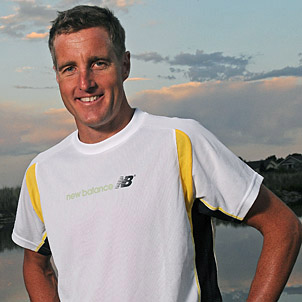
ST: Early this season, by your highest standards, you had a moderately successful non-drafting season leading up to Hy-Vee. Taken with your mediocre finishes at WCS races, some might say these results signaled you were past your prime. How did you peak to beat the world at Hy-Vee?
Greg: I had a plan for Hy-Vee early in the year. When I saw the course I saw Hy-Vee suited me very well. So with the Olympics in mind for next year, I wanted to start the season with WCS events in Sydney, Madrid, and Kitzbuhel. To be honest I missed my goals at those races. I really had very disappointing races and was not pleased how I performed.
ST: Why did you do so poorly?
Greg: I was largely missing some intensity with the way I approached them. When I was training with Gomez at Noosa, I could clearly see he was faster than me. But I was confident I could do better as the season developed. But in Sydney it rained and I was not comfortable on the bike. I felt I could crash at any moment. In Madrid I flew in too late the night before a 10 AM start and I felt asleep the whole race. At Kitzbuhel, I lost 11 seconds in transition – it was freezing cold and that 11 seconds made the difference between a 13th and the 25th.place where I ended up.
ST: Pretty discouraging,. Why didn’t you lose heart when you turned your attention to Hy-Vee?
Greg: Taking all my WCS races together, all three were very, very disappointing. When I came I came back after Kitzbuhel knew I had to do some 5150 races to qualify for Hy-Vee. It was tough. I said to Laura “In order to win Hy-Vee, I have to work hard on a time trial bike.” I was in Europe on a Tuesday, on Wednesday I booked a ticket to Philly and managed to get 3rd behind Andy [Potts] and Matt [Reed] in the Race to the Toyota Cup series event. In that race I got some energy back and I really enjoyed it. I was so happy to be reminded of why I love the sport and how much I enjoyed the USA circuit more than ITU. Then I went to Minneapolis two weeks later on a Saturday. I knew there were only a few opportunities to find 5150 races to qualify, so I raced Minneapolis [a Life Time Fitness – Toyota Cup race] and took 3rd to Matt and Andy. I felt pretty comfortable and then flew in and raced the 5150 race at Boulder Peak the next day – Sunday – and got 3rd. That 3rd place almost got the slot for Hy-Vee. But it wasn't a sure thing, and I knew there was one more 5150 race was left – New York City. I flew in after Laura’s race in London, [where Greg Bennett did not have enough ranking points to start the men’s race]. I got in Saturday night at 11 PM and got to the race at 5:45 and. managed to get 2nd there behind Ben Collins. So I did what I needed to do get into the series.
ST: You said you had a plan how to attack the race. Perhaps it had to be more subtle now that you are not at the peak of your powers? Assuming you at 39 are not as fast or as strong as you were 5 or 10 years ago?
Greg: You are not wrong. Look, the peak of my powers was '02 and '03 and '07 and '08. But back in '07, '08 I had to beat Craig Walton and he was the one who made me get the best of myself in my career to beat him. He laid down a swim-bike combination no one had ever seen – and to beat him I had to run 31 minutes flat after time trialing a 54 minute 40k bike. That was the highlight of my athletic career and he is the guy who made me rise to the occasion.
ST: So what was your race plan for Hy-Vee 2011?
Greg: I knew I needed to swim with the lead pack.
ST: There was a wicked current in the river in Des Moines that seemed to make the weaker swimmers go backward. How did that play into your strategy?
Greg: I grew up in Australia and so I love the surf or any form of movement in the swims. It just makes it a little more tactical and a little more fun. I worked the currents pretty well at Hy-Vee. It was one of the most fun swim courses I've ever done.
ST: What about on the bike? No drafting but contact is important.
Greg: This was a very technical bike. Before the race I worked very hard on cornering a time trial bike in the mountains around Boulder. I made sure I practiced taking corners as fast as you can.
ST: When did that come into play on the Hy-Vee bike leg?
Greg: Bertrand Billard is a big Frenchman who won two big European 5150s. When I got on the bike I knew he would come up and go very fast. I had visualized this before the race and was determined to keep up with him whenever he goes. He pushed the pace and strung out guys who fell back in the pack. But I stuck with him. When he got tired around 25k, I did not want to wait around there. I could see Matt Reed wasn't far back and I knew I needed to open up seconds on Matt and the guys with him. I needed to ride harder to push them all into a strength run. A slow grinding run suits me these days.
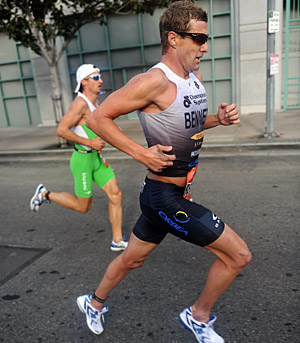
ST: You’ve raced and won in Hamburg where the crowds were enormous and the cheering is loud and the atmosphere is electric. How did Des Moines compare?
Greg: The crowds were amazing, outstanding. No doubt I have to put the Des Moines crowd on par with Hamburg. I don’t know numbers. But I know how it feels to run to the finish on the streets with people cheering for you all 10k on the run. It's a really special feeling and when I think back it still gives me goose bumps. On the uphill finish I did not feel my feet hit the ground. It was a really amazing and it took me a week to recover such an emotional high. I was flat for a week. To follow that highs is hard. But if you are fit, you can bounce back pretty well and back it up the next race.
ST: You'd be great in Ironman. Are you tempted?
Greg: The Ironman crossed my mind last decade multiple times. One thing I think that has helped me maintain my career over a long period of time is that I recognized where my talents and passion were very early. Now no doubt the feeling of winning Ironman Hawaii would be absolutely brilliant. But for me, anything else but a win does not interest me remotely. I'm a power and speed athlete. Physically, mentally and emotionally it's who I am.
ST: So, Hy-Vee or IM Hawaii?
Greg: A win at Hy-Vee, for me personally, makes me as happy as if I won Ironman Hawaii. That's my personal opinion. I love to race. I love to race a power event. I am a natural high threshold athlete — not a natural strength endurance athlete.
ST: You’d think you could train to do very well at Hawaii?
Greg: I'll be happy just watching all my mates race. Laura and I will go down again this year. We enjoy being at the event.
ST: As you approach 40, are you pushing back the limits of age?
Greg: Fair enough. Triathlon had Dave Scott who in 1994 was 2nd in Hawaii at age 40. Rob Barel raced the Sydney Olympics at age 42. But there haven’t been too many guys who pushed 40 years and developed enough strength and power to win major events. Macca and Crowie and Hunter and Whitfield are 2-4 years younger than I and say they have been inspired a little by me to keep it going. Maybe we will be the first generation to push it along.
ST: Is it getting harder to go out the door and train every day?
Greg: I still love it — some days it seems like I wish to be retired. But those days are minimal. Most of the time I come home from training and feel fortunate for the life I lead and what I have.


